Futures trading can be expensive, but choosing the right broker can save you thousands annually. Brokers like NinjaTrader and AMP Futures offer some of the lowest commission rates in the U.S., starting as low as $0.09 per contract. However, commissions are just one piece of the puzzle – exchange fees, platform charges, and other costs can add up. Here’s what you need to know:
Quick Highlights:
- NinjaTrader: Low commissions with flexible pricing plans and advanced trading tools.
- AMP Futures: Low rates and a unique unlimited commission-free trading plan for $1,000 annually.
- Discount Trading: Simple, tiered pricing for frequent traders.
- Webull: Flat-fee model with a user-friendly mobile platform.
- TradeStation: Powerful tools and tiered pricing for high-volume traders.
- Interactive Brokers: Flexible pricing and professional-grade tools.
- Optimus Futures: Flat-rate pricing and access to multiple platforms.
- tastytrade: Flat $2.25 per contract with a $22.50 cap per trade.
Key Takeaway:
Low commissions are important, but also consider platform features, account minimums, and additional fees when choosing a broker. The right choice depends on your trading volume, strategy, and budget. Below, we break down the top brokers to help you decide.
The @futuresfanatic ‘s Favorite Futures Brokers For Beginners
1. NinjaTrader
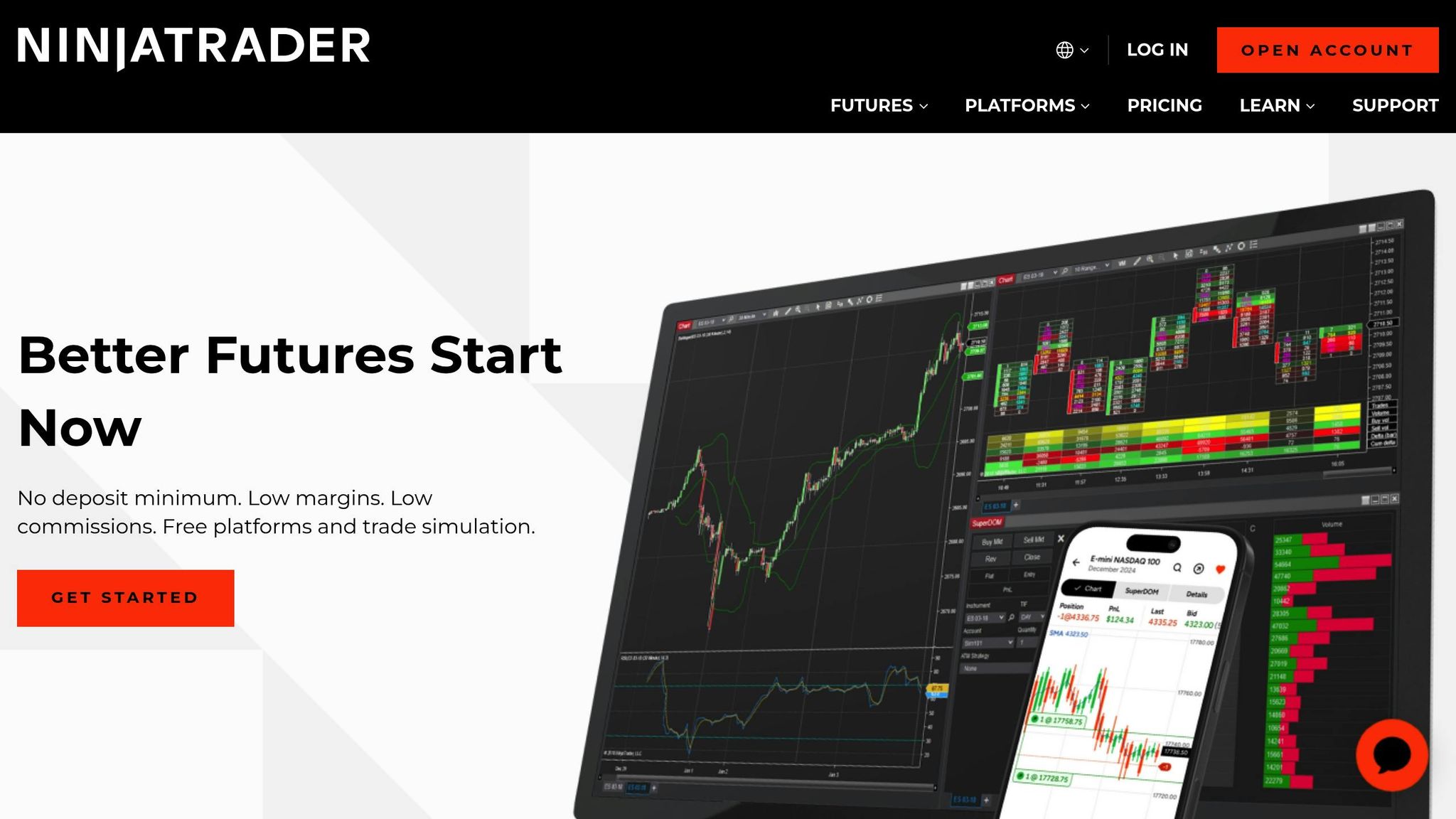
NinjaTrader is a well-regarded, budget-friendly option for futures trading, offering a flexible dual pricing model to suit different trader preferences.
Commission Rates
NinjaTrader provides two pricing options tailored to traders’ needs. The first is a commission-based model, where per-contract fees decrease as trading volume increases – perfect for high-volume traders looking to save on costs. The second is a leasing model, which combines a fixed monthly fee with per-contract charges. This option works well for traders who prefer predictable costs without needing to trade in large volumes. Both structures are paired with low account requirements, making the platform accessible to a wide range of users.
Minimum Deposit
Opening a futures trading account with NinjaTrader requires a low minimum deposit, making it an attractive choice for beginners or those with limited starting capital.
Platform Features
NinjaTrader goes beyond competitive pricing by offering a suite of powerful tools. Its desktop platform includes advanced charting capabilities, built-in technical indicators, automated trading strategies through NinjaScript, real-time data feeds, efficient order management, and backtesting tools. For traders handling complex strategies or multiple charts, pairing NinjaTrader with QuantVPS enhances performance, offering ultra-low latency and guaranteed uptime.
Additional Costs
While NinjaTrader’s commission rates are appealing, traders should also account for other fees. These include exchange, regulatory, and market data charges. A monthly fee for real-time market quotes might apply, though traders with higher volumes may qualify for fee waivers. Additionally, accessing extra exchanges or premium data packages will incur varying costs based on the markets traded.
For those who want to practice without risking money, NinjaTrader offers a free simulation account. However, live trading requires either paying the monthly lease fee or meeting the volume thresholds under the commission-based plan.
2. AMP Futures

AMP Futures stands out by offering low commissions and a promise to MATCH or BEAT any Written Commission Quote, making it an attractive option for traders focused on keeping costs down.
Commission Rates
AMP Futures provides an All-In Cost Calculator to help traders easily understand their expenses. This tool consolidates commissions, exchange fees, NFA charges, platform costs, and routing fees. Rates are quoted per contract, per side, and apply volume tiers based on monthly trading activity.
For high-volume traders, AMP offers a unique option: unlimited commission-free trades for one year with a one-time $1,000 annual fee. While this plan still includes exchange fees, NFA fees, a $0.50 clearing fee per contract, trade routing, platform costs, and monthly data fees, it can offer notable savings for those trading frequently.
New traders can explore the platform risk-free with 20 commission-free trades, giving them a chance to test its features without initial trading costs.
Minimum Deposit
A minimum deposit of just $100 grants access to live data. However, the actual balance needed to start trading depends on the day trade margin requirements for the specific contracts being traded.
Platform Features
Traders using AMP Futures can choose from over 50 trading platforms and access 4 data feeds (CQG, TT, Rithmic, and Teton) without paying monthly platform fees. Full-featured versions of these platforms are available across multiple devices, ensuring traders can stay connected and manage their accounts from anywhere.
Additional Costs
In addition to the $0.50 clearing fee per contract, traders are responsible for standard exchange, NFA, and regulatory fees. Monthly exchange data fees vary depending on the market and selected data packages. For options trading, the commission structure mirrors that of futures, although exchange fees may differ based on the specific options contracts traded.
3. Discount Trading
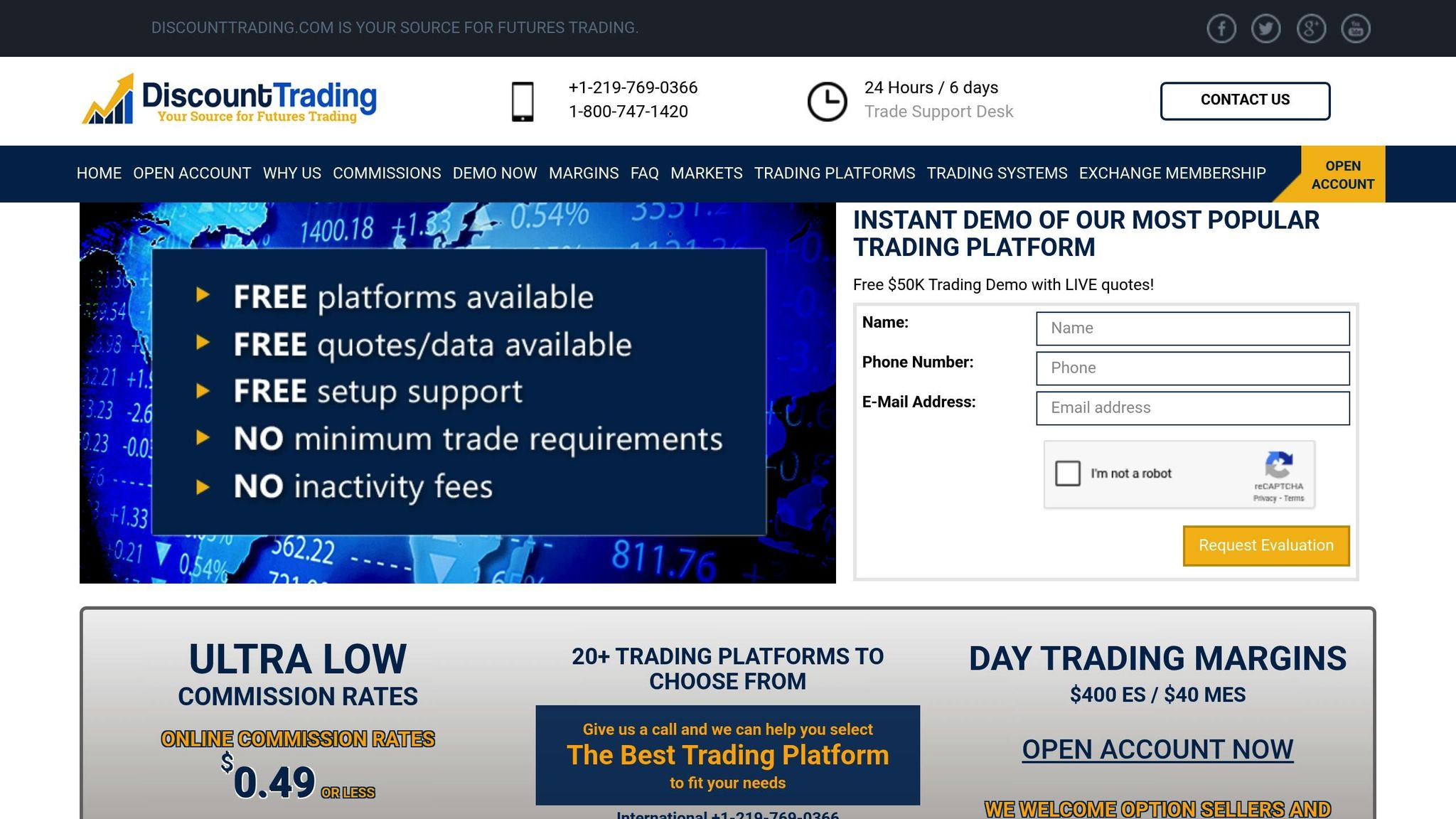
Discount Trading stands out for its focus on low-cost futures trading, offering a straightforward fee structure that prioritizes transparency. It’s particularly appealing to traders who want to keep costs down, with a tiered commission system that benefits those who trade frequently.
Commission Rates
This broker uses a tiered pricing model that includes clearing and most regulatory fees. This setup allows traders to clearly understand their costs before they start trading.
Minimum Deposit
With a low minimum deposit requirement, Discount Trading is a good fit for beginners or those managing smaller accounts. Keep in mind, though, that margin requirements will depend on the specific market you’re trading in.
Platform Features
Discount Trading provides access to professional-grade trading platforms equipped with advanced tools. These include sophisticated charting options, real-time market data, and efficient order management systems. Traders also gain direct access to major U.S. exchanges, enabling them to manage orders across multiple markets seamlessly from one platform.
Additional Costs
While the commission structure is transparent, there are other costs to consider. These include exchange fees, regulatory charges, and subscription fees for real-time data. There may also be maintenance or transfer fees, so it’s a good idea to check the full fee schedule for a complete picture of potential expenses.
4. Plus500 Futures
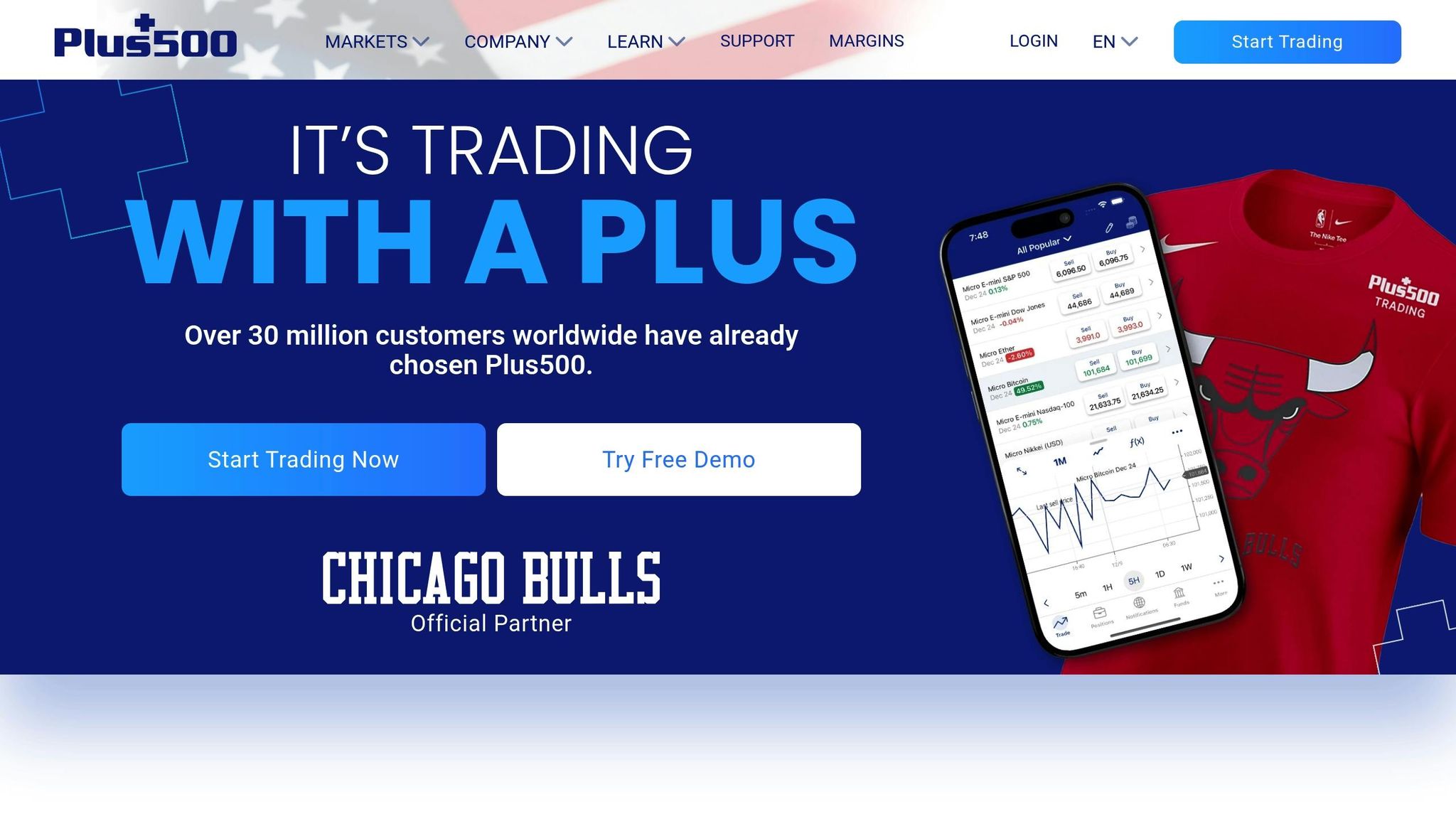
We’re currently gathering verified details about Plus500 Futures. Once the information is confirmed, we’ll provide an in-depth update to ensure this futures broker analysis is as thorough and accurate as possible. Stay tuned!
5. Webull
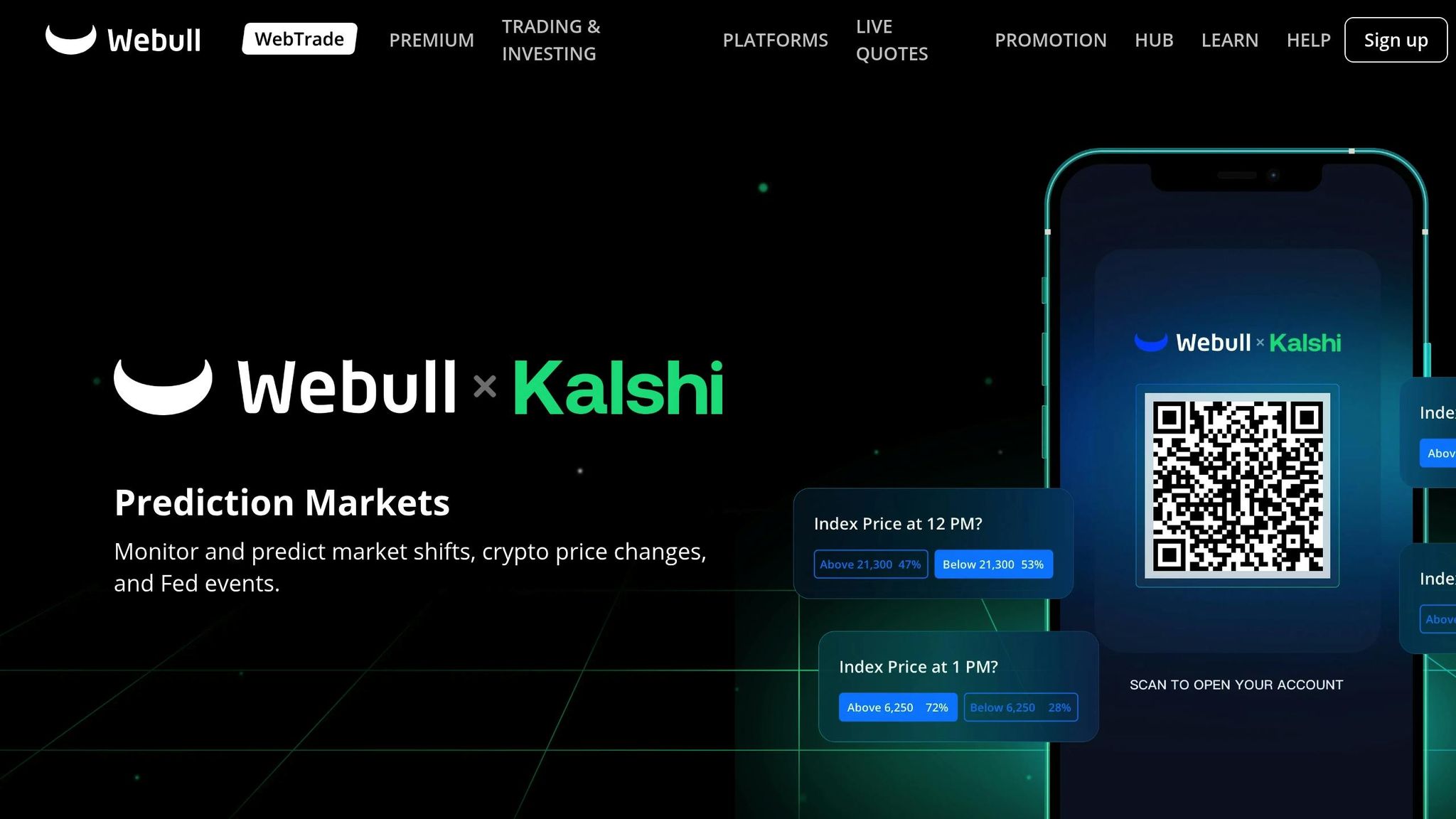
Webull has entered the futures trading space with a flat-fee commission structure and a sleek, user-friendly platform.
Commission Rates
Webull uses a flat-fee model for futures trading. This applies to both opening and closing positions, making it easier for traders to calculate their total costs upfront. The straightforward pricing pairs well with the platform’s accessible account setup.
Minimum Deposit
The required deposit is designed to meet the margin requirements for popular futures contracts, keeping entry barriers low.
Platform Features
Webull’s platform includes real-time market data, advanced charting tools, and a variety of technical indicators. These features, combined with customizable drawing tools, allow for detailed market analysis.
The mobile app supports full futures trading functionality, including market, limit, stop, and stop-limit orders. This means you can track markets, manage your positions, and execute trades no matter where you are.
For those looking to test their skills without financial risk, Webull also offers a paper trading feature. It’s a great way to practice strategies before putting real money on the line.
Additional Costs
Exchange and regulatory fees are passed directly to users at cost. Keep in mind that margin requirements for holding overnight positions may differ from those for day trading.
6. TradeStation
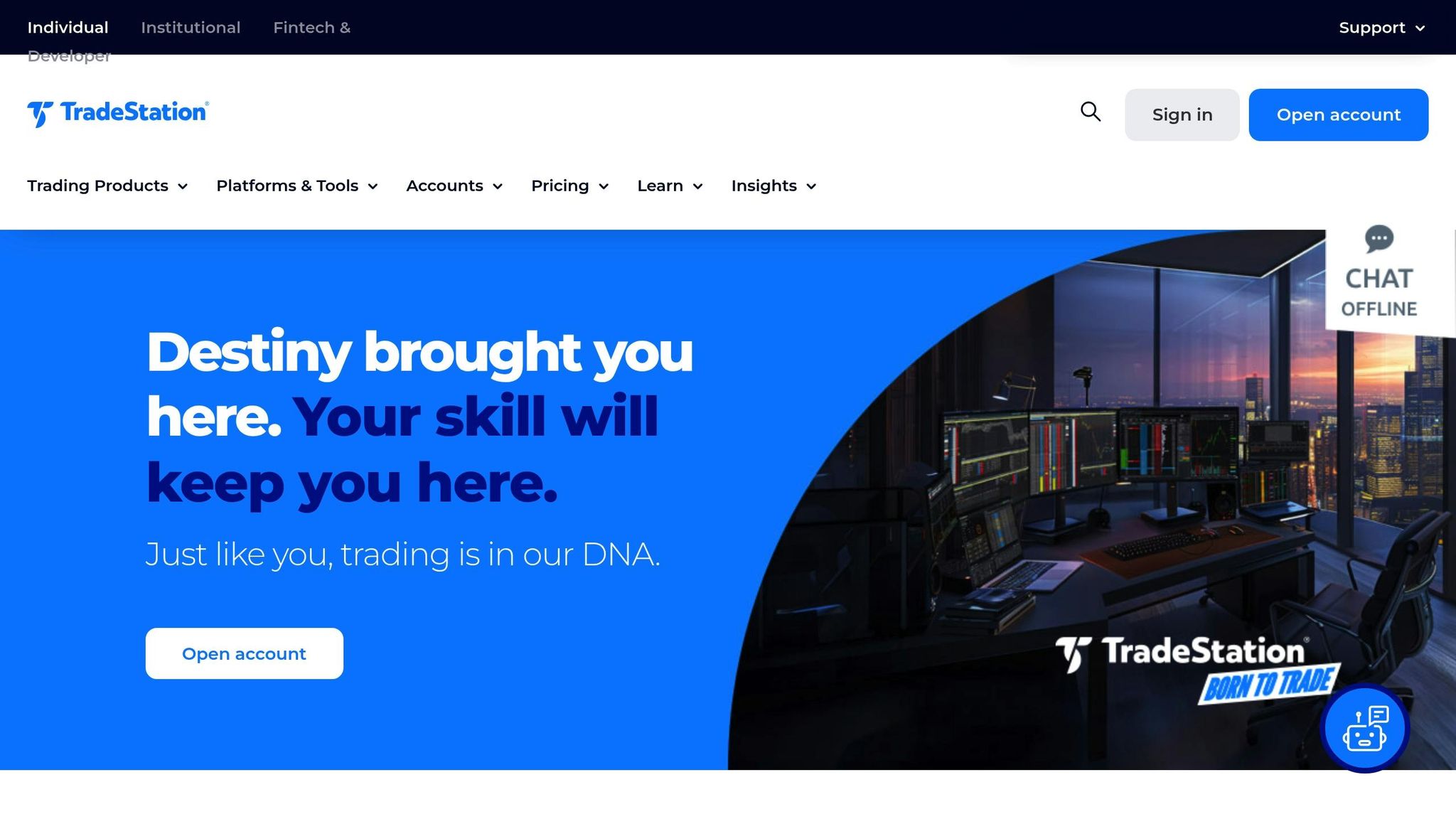
TradeStation has carved out a strong position in the futures trading space, offering a robust platform with competitive pricing. Known for catering to both active day traders and those holding longer-term positions, it provides advanced tools and dependable trade execution. Let’s dive into its commission structure, account requirements, platform features, and additional costs.
Commission Rates
TradeStation keeps costs straightforward with its per-contract pricing model. Standard accounts start at $1.50 per contract, charged on both the opening and closing of a trade. For traders who execute higher volumes, the platform offers tiered pricing and volume discounts, making it more cost-effective.
Minimum Deposit
To open a futures trading account, TradeStation requires a $500 minimum deposit. This relatively low entry point makes it accessible for beginners while adhering to regulatory requirements for futures margin trading.
Platform Features
TradeStation’s platform is packed with tools designed for serious traders. It offers institutional-grade charting with over 270 customizable indicators, multi-monitor support, and personalized workspace layouts, all tailored for in-depth market analysis.
One standout feature is RadarScreen, which enables real-time scanning and monitoring across multiple markets simultaneously. This tool is invaluable for identifying opportunities without needing to manually track each futures contract.
For traders who enjoy building their own tools, TradeStation’s proprietary programming language, EasyLanguage, allows users to create custom indicators, strategies, and even automated trading systems. This feature is a game-changer for those who want to fine-tune their technical analysis or automate their trading processes.
The platform’s mobile app is equally impressive, retaining much of the desktop functionality. Whether you’re placing trades, monitoring positions, or analyzing charts, the app ensures you stay connected when you’re on the go.
Additional Costs
In addition to commission fees, TradeStation applies exchange and regulatory fees, which range from $1.20 to $4.80 per contract, depending on the market.
Market data fees are another consideration. While basic data is included, active traders may need to subscribe to premium feeds for real-time quotes.
It’s also worth noting that overnight margin requirements are higher than day trading margins, which is standard across the industry. TradeStation provides clear margin details for each contract, making it easier to manage your account equity and avoid surprises.
These features and costs create a well-rounded trading environment for both new and experienced futures traders.
7. Interactive Brokers
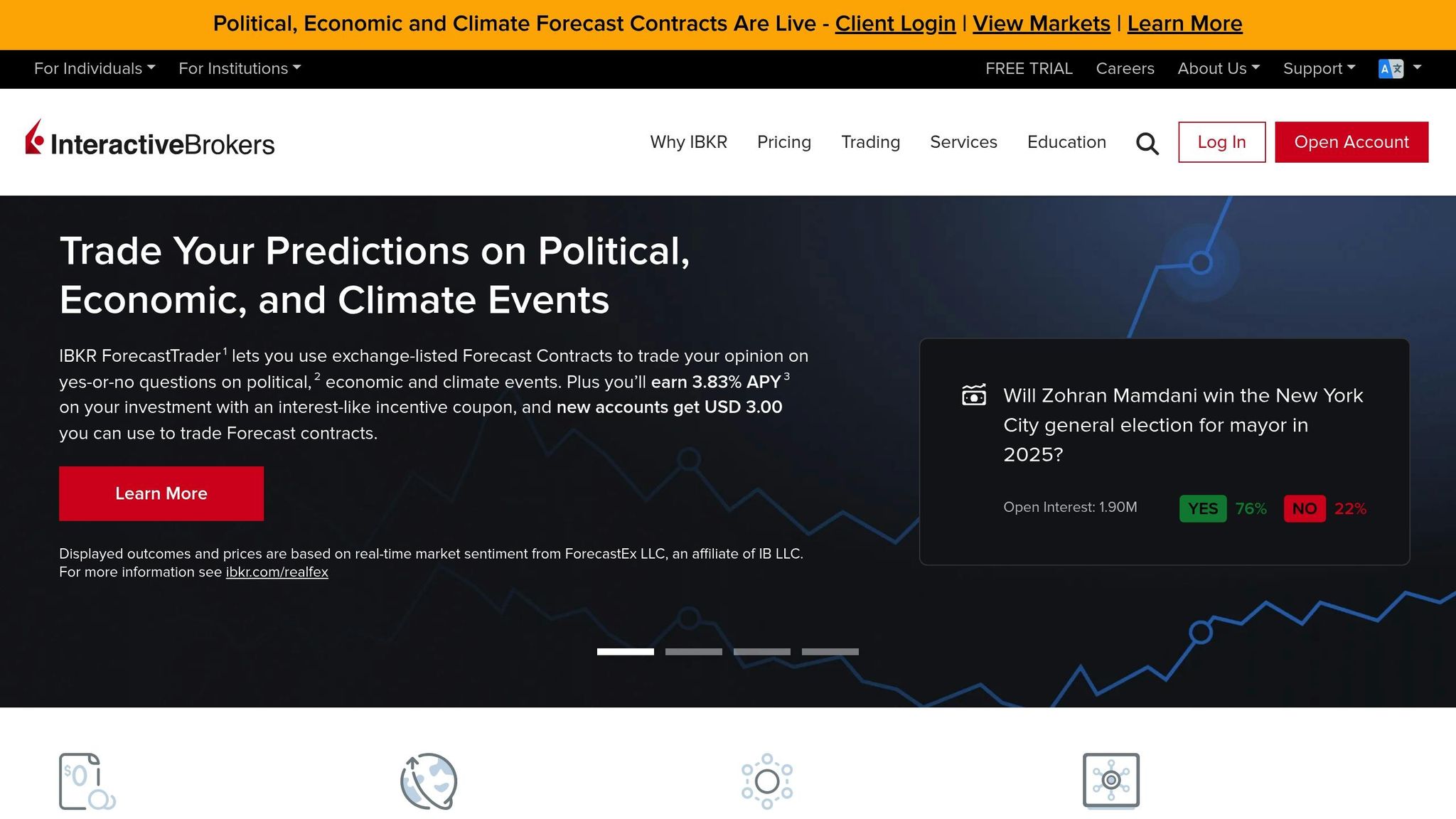
Interactive Brokers is a go-to platform for active traders looking to dive into futures trading, offering tools and features designed for professionals.
Commission Structure
Interactive Brokers provides two pricing models: a tiered structure, where fees drop as your monthly trading volume increases, and a fixed pricing option for those who prefer consistency. This flexibility gives traders the ability to choose what works best for their trading style and goals.
Account Requirements
To access Interactive Brokers, you’ll need to meet a higher minimum deposit requirement. While this might feel like a hurdle, it’s designed to ensure traders have enough margin to leverage the platform’s advanced tools effectively.
Platform and Trading Tools
The Trader Workstation (TWS) platform is packed with features like advanced charting, risk management tools, and portfolio analytics. You can also customize layouts and use the market scanner to identify opportunities in real time.
For algorithmic traders, the platform supports API access with multiple programming languages, allowing for tailored trading strategies. Mobile apps for both iOS and Android extend many desktop functionalities, making it easy to manage trades from anywhere. That said, while the tools are robust, keep an eye on associated costs.
Additional Costs
Beyond commissions, traders should budget for exchange and regulatory fees, as well as optional extras like market data and account maintenance fees.
With its competitive fee structure and professional-grade tools, Interactive Brokers stands out as a strong choice for futures traders who value both cost-conscious trading and advanced capabilities.
8. Optimus Futures
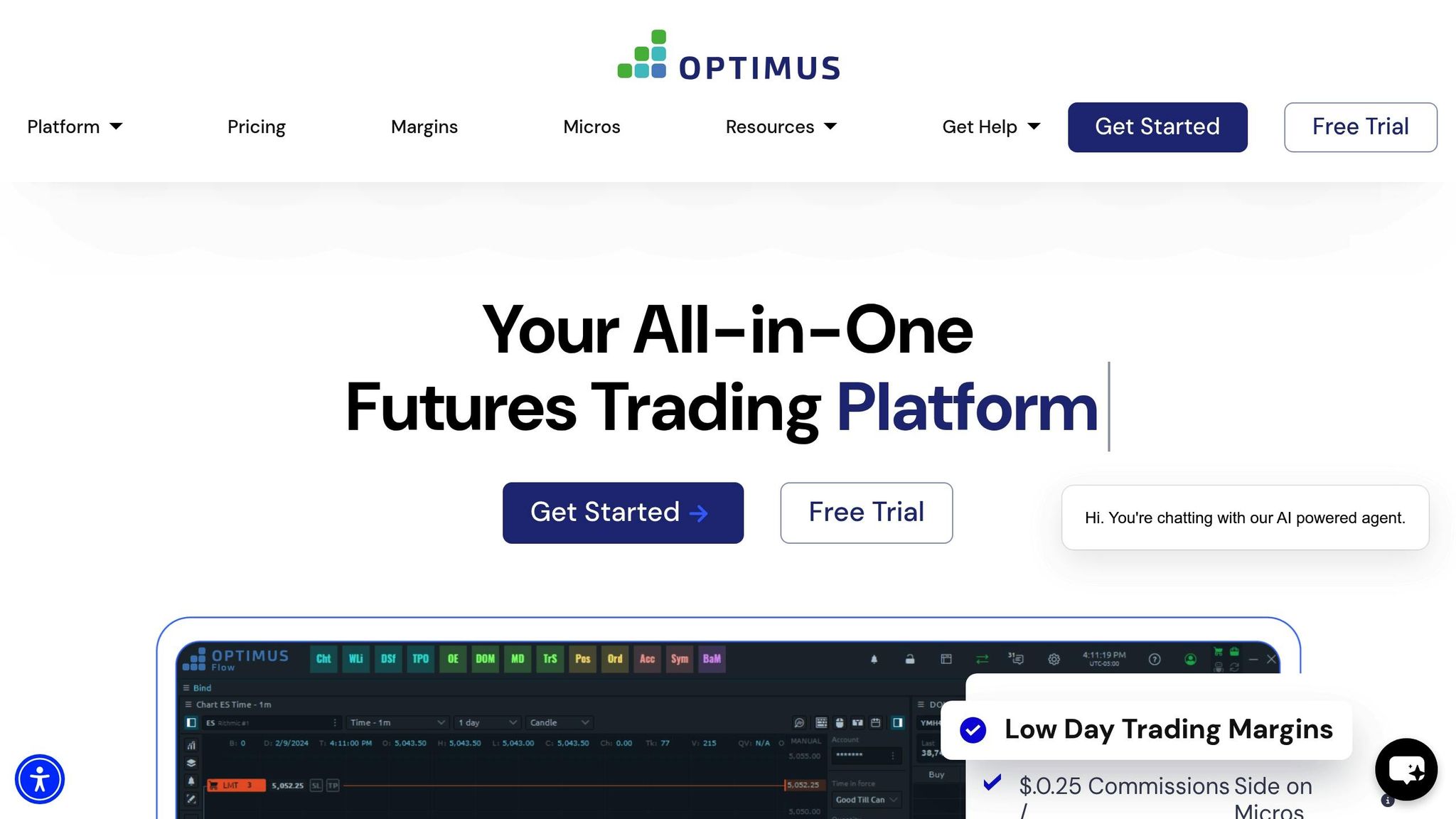
Based in Chicago, Optimus Futures offers a simple, flat-rate commission structure with competitive pricing.
Commission Rates
Optimus Futures uses a flat-rate commission for most futures contracts, making costs easier to understand. They also provide reduced rates for micro futures contracts, which can be a great option for newer traders or those with smaller accounts. Additionally, they offer round-turn pricing, which combines the fees for opening and closing a position into a single charge.
Minimum Deposit
The broker’s low minimum deposit requirement makes it an appealing choice for retail traders. Whether you’re just starting out or testing strategies with a smaller balance, this lower entry point provides flexibility without requiring a significant financial commitment.
Platform Features
Optimus Futures provides access to several popular trading platforms and direct market access, ensuring your orders go straight to the exchange without unnecessary delays. For traders interested in automation, the broker supports API connectivity, making it easier to implement algorithmic trading strategies. Mobile trading options are also available, allowing you to monitor and manage your trades wherever you are. These tools align well with their pricing model, helping to streamline execution.
Additional Costs
While there are no account maintenance or inactivity fees, traders should be aware of additional costs like exchange and regulatory fees per round-turn. Optional expenses, such as market data or wire transfer fees, may also apply. However, the absence of hidden costs keeps overall expenses more transparent and manageable.
9. tastytrade
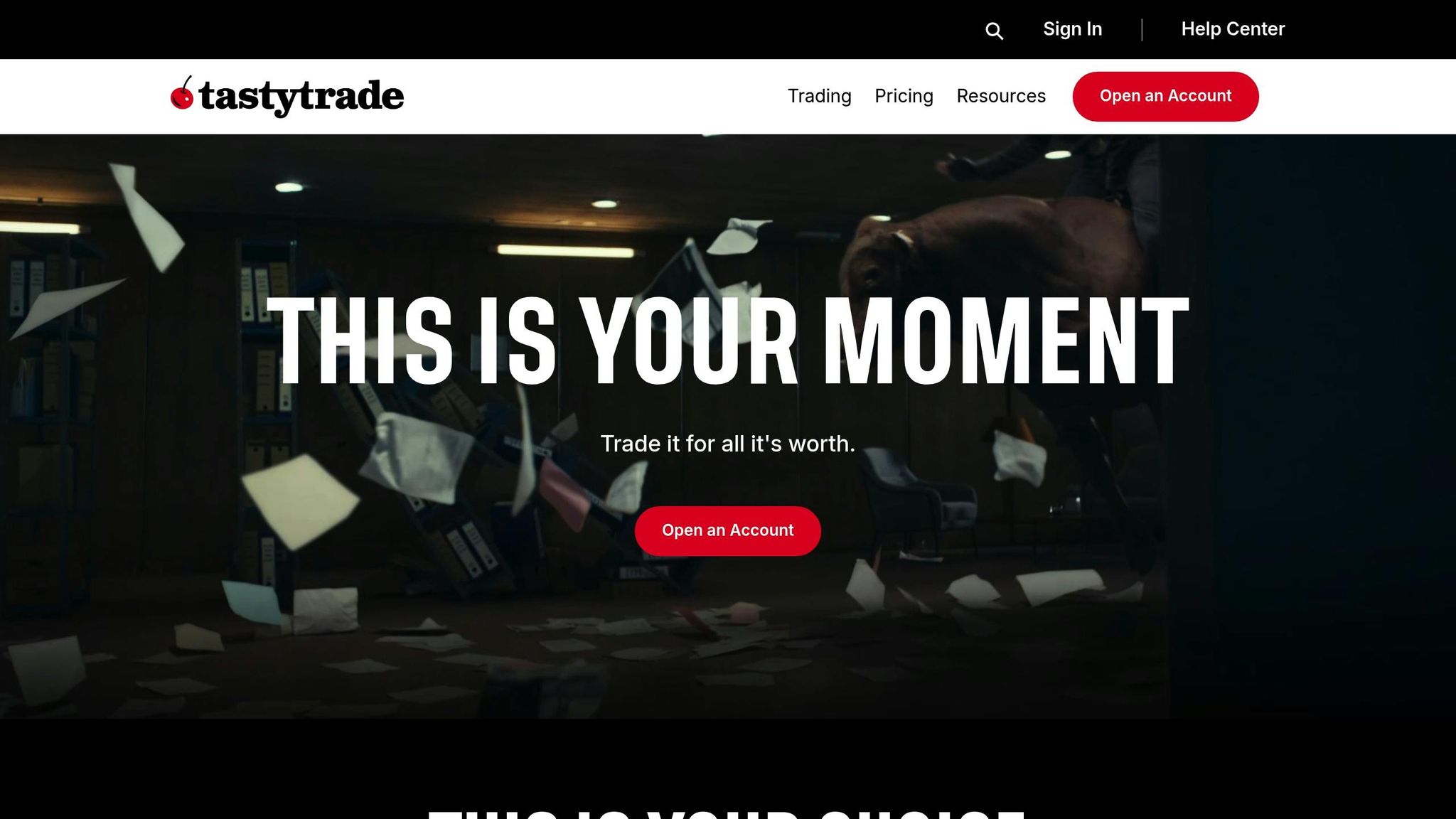
tastytrade has earned a name for offering clear pricing and tools tailored for active traders. Based in Chicago, this broker focuses on meeting the needs of frequent traders with a simple commission structure and advanced trading features.
Commission Rates
For futures trading, tastytrade charges a flat $2.25 per contract, with no extra fees for opening or closing positions. This straightforward rate applies to most standard futures contracts, making it easy to estimate trading costs. The same rate applies to micro futures, even though the per-contract cost is relatively higher due to the smaller size of these contracts.
One standout feature is the $22.50 commission cap per trade. If you trade 10 or more contracts in a single order, your fees won’t exceed this cap, making larger trades more economical on a per-contract basis. This pricing structure pairs well with the platform’s advanced tools, which we’ll explore next.
Minimum Deposit
To open a futures trading account with tastytrade, you’ll need a minimum deposit of $2,000. This requirement reflects the broker’s focus on active traders and ensures that users have enough capital to handle margin requirements and the inherent volatility of futures markets.
Platform Features
tastytrade’s platform is designed with active traders in mind, offering tools that resemble an options-trading approach. Key features include real-time streaming quotes, advanced charting tools, and integrated news feeds. The platform also supports mobile trading, with full functionality available on iOS and Android apps, so you can stay connected to the markets wherever you are.
Trade management is a strong point, with tools for automated profit-taking, conditional orders, and alerts. For those looking to test strategies without financial risk, the platform includes a paper trading feature, allowing you to refine your approach before committing real capital.
Additional Costs
While the base commission is straightforward, traders will also need to account for standard exchange and regulatory fees, which typically range between $1.00 and $4.00 per round-turn trade, depending on the contract and exchange. However, tastytrade does not charge for account maintenance or inactivity, keeping ongoing costs low.
For real-time market data, fees apply. For example, CME Group data costs about $4.50 per month, with additional fees for other exchanges. Active traders who meet specific trading volume requirements may qualify for fee waivers. Domestic wire transfers incur a $25 fee, but ACH transfers for deposits and withdrawals are generally free, adding to the platform’s cost efficiency.
10. Tradier
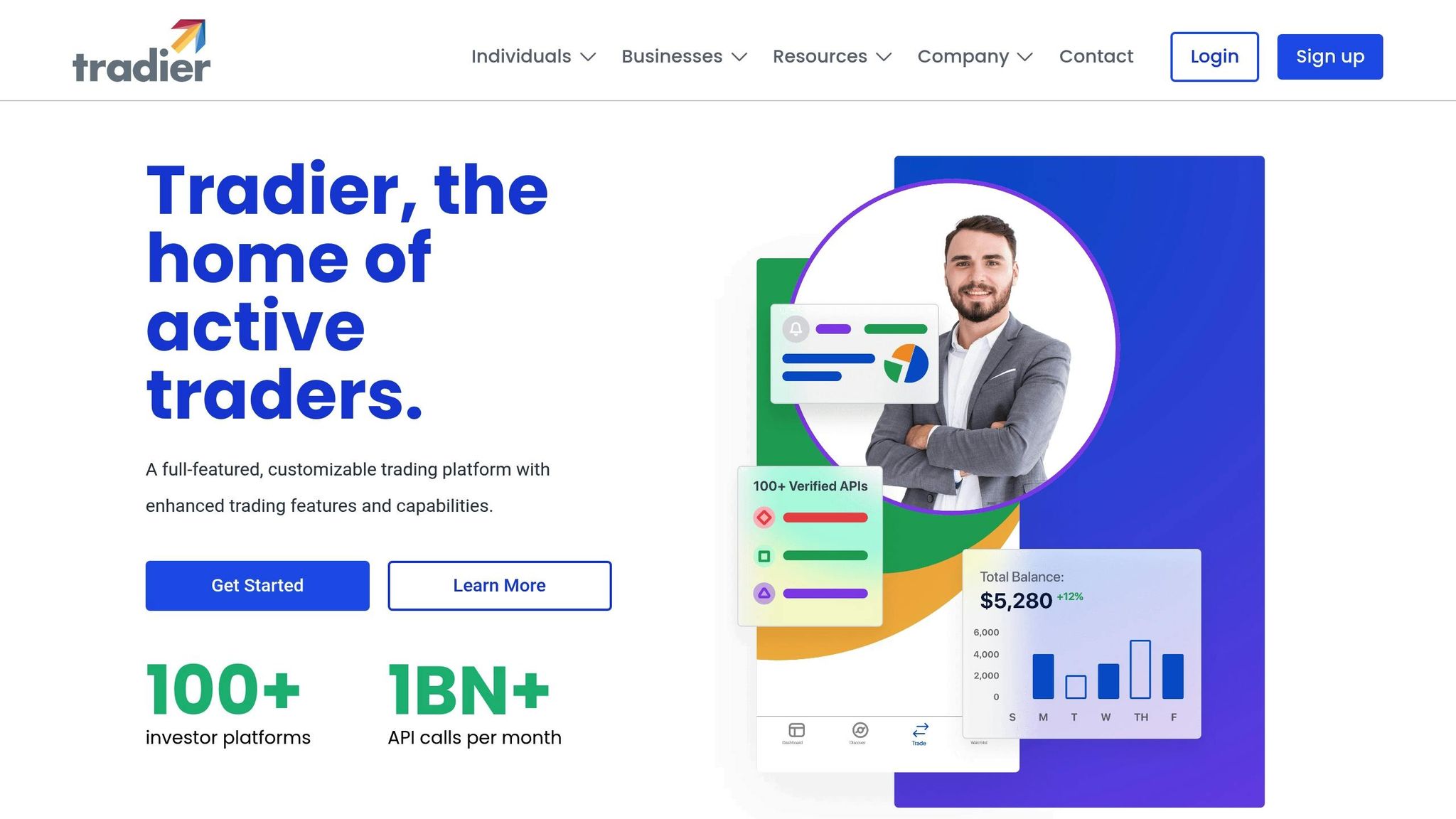
Tradier stands out among U.S. futures brokers thanks to its transparent pricing and flexibility, especially with its API-driven trading solutions.
Tradier operates as a cloud-based broker, providing a straightforward trading experience with clear fees and tools suitable for traders at all levels.
Commission Rates
Tradier keeps things simple with flat commission rates for both opening and closing positions, making it easier to manage trading costs. For the most up-to-date details, check Tradier’s official resources.
Minimum Deposit
A minimum deposit is required to open an account. For exact details, refer to Tradier’s account guidelines.
Platform Features
Tradier’s platform offers a clean and easy-to-navigate web interface with real-time quotes, basic charting tools, and streamlined order management. Its mobile apps bring these features on the go. The platform’s API-first design allows seamless integration with third-party tools and supports a variety of order types.
Additional Costs
In addition to commissions, traders should expect standard exchange, regulatory, and market data fees. The good news? Tradier doesn’t charge maintenance or inactivity fees. For wire transfers or account-related fees, consult Tradier’s fee schedule for specifics.
Broker Comparison: Pros and Cons
When it comes to futures trading, finding the right broker isn’t just about looking at commission rates. It’s about understanding how each platform’s features, usability, and potential costs align with your trading needs. Below, we’ve outlined the key advantages and drawbacks of some popular brokers to help you weigh the options.
| Broker | Key Advantages | Notable Drawbacks |
|---|---|---|
| NinjaTrader | Highly-rated multi-device platform with over 1.9 million users; Free unlimited simulated trading; Extensive third-party add-ons; C# development framework; 24/7 support | Steep learning curve for beginners; advanced features may feel overwhelming |
| AMP Futures | Low commissions; Competitive research tools; Offers multiple platform choices | Fewer educational resources compared to larger firms |
| Plus500 Futures | User-friendly web platform with a clean design; Focuses on simplicity for traders | Limited advanced order types; Minimal third-party integration |
| Webull | Fast, intuitive mobile app; Customizable drag-and-drop desktop dashboard; Built-in trader community for learning; Displays margin requirements clearly | Charting tools are less detailed than competitors; Lacks robust futures-specific education |
| TradeStation | Advanced desktop platform with powerful tools; APIs and scripting for automated trading; Extensive historical data for backtesting | Platform usability can be challenging; Frustrating user experience reported by some |
| Interactive Brokers | Access to global markets with institutional-grade tools; Over 90 order types and algorithms; Excellent execution with Adaptive Algo; Strong backtesting options | Complex interface may intimidate new traders; requires time to master |
| Optimus Futures | Works with 20+ platforms like TradingView; Tools like DOM Heatmap and Market Replay; Free platform with unlimited simulated trading; Futures score: 4.7/5 | Managing multiple platforms can be cumbersome; may involve separate logins |
| tastytrade | Simple, intuitive platform for active traders; Real-time data and clear margin guidance | Limited research tools compared to full-service brokers; less beginner-friendly educational content |
| Tradier | Solid research tools | No desktop platform available |
Key Considerations for Choosing a Broker
Costs Beyond Commissions
While lower commission rates might catch your eye, they don’t always guarantee the best deal. Hidden fees – like exchange, regulatory, and data costs – can quickly add up. Some platforms also charge for access or require minimum deposits, which can impact your bottom line.
Platform Complexity vs. Usability
The level of sophistication varies widely. For example, NinjaTrader boasts a feature-rich platform with a 4.7/5 futures score and is rated #1 by over 1.9 million users, but its complexity may deter beginners. On the other hand, Plus500 Futures opts for a sleek, user-friendly design, prioritizing simplicity over advanced tools.
Mobile Accessibility
In today’s fast-paced trading environment, a strong mobile app is crucial. Webull stands out with its quick and customizable mobile platform, while some brokers struggle to replicate desktop functionality on mobile devices.
Learning Curve
Ease of use varies significantly. Interactive Brokers’ Trader Workstation offers institutional-grade features but can overwhelm new traders. Meanwhile, tastytrade’s straightforward design focuses on simplicity, making it more approachable for those just starting out.
Ultimately, choosing the right broker comes down to striking a balance between advanced functionality, user experience, and overall costs. It’s not just about saving on commissions – it’s about finding a platform that aligns with your trading style and long-term goals.
Conclusion
Choosing the right futures broker with low commissions involves more than just comparing rates – it’s about finding the right balance between costs and trading tools that meet your needs. While low commission rates might catch your eye, the true cost of trading often includes platform fees, data charges, and execution quality.
For traders focused on keeping costs low, brokers like NinjaTrader and AMP Futures stand out with competitive pricing and feature-rich platforms. If you prioritize speed and advanced tools, Interactive Brokers offers a wide range of order types and powerful trading capabilities. Similarly, TradeStation provides a robust desktop platform with advanced backtesting and automation tools, making it ideal for traders who rely on detailed analytics.
For those who prefer mobile trading, Webull delivers a user-friendly app with clear margin displays, although its charting features may be less detailed. Beginners might find Plus500 Futures appealing for its clean, straightforward interface, while tastytrade offers an easy-to-navigate design, even if its research tools are more basic compared to larger, full-service brokers.
Ultimately, your choice of broker should align with your trading style. A platform with low per-contract fees but lacking essential features could end up costing you more in the long run. Consider factors like how often you trade, the devices you use, your need for advanced tools, and your comfort level with platform complexity.
FAQs
What other costs should I consider when selecting a futures broker beyond commission rates?
When picking a futures broker, it’s crucial to look beyond just the commission rates. Other costs can quickly add up, such as exchange fees, market data fees, platform or account maintenance charges, and transaction-related costs like ticket fees or foreign transaction expenses.
For instance, certain brokers might apply exchange fees that differ based on the type of contract, while others could charge for access to live market data or penalize you for having an inactive account. Taking the time to thoroughly review a broker’s fee structure can help you steer clear of unexpected costs and choose an option that aligns with your trading budget.
Why do platform features and ease of use differ among top futures brokers, and how does this impact traders?
Platform Features and Ease of Use
The features and usability of a trading platform can make or break a trader’s experience, especially in the fast-moving world of futures trading. A platform with easy-to-navigate menus, real-time market data, and powerful tools ensures traders can act swiftly and precisely, minimizing errors that could lead to costly missteps.
Key features like advanced charting capabilities, flexible order customization, and automation tools are invaluable for managing risk and boosting trading efficiency. For futures traders, a dependable and straightforward platform isn’t just a nice-to-have – it’s a critical asset for staying ahead in the game and making smart, timely decisions.
What should beginners look for in a low-commission futures broker?
When you’re new to futures trading, picking the right broker can make all the difference. Look for a platform that’s easy to use and performs reliably – this will help you focus on learning the ropes instead of struggling with complicated tools. Just as important, choose a broker that’s regulated and has solid security measures to keep your investments safe.
While low commissions sound appealing, don’t forget to factor in the total cost of trading. This includes things like exchange fees, data fees, and clearing fees. A broker with clear, upfront pricing and minimal hidden charges can help you manage your costs more effectively as you build your trading skills. By keeping these points in mind, you’ll set yourself up for a smoother and more secure start in futures trading.








